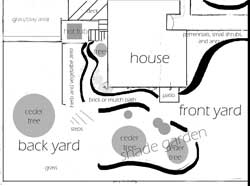A couple of rough sketches of my yard:


A couple of rough sketches of my yard:


I have a lot of ideas for the yard, but as pretty as they look on paper, they just aren't feasible right now. Instead, I plan on creating simple beds that are built around a theme, such as a shade garden or herb garden.
Garden site description
Owner: Stacey
Location: South Olympia
Garden plan will be implemented in the front, side, and back yard. I have included
a master plan and a more detailed plan that will be put into effect this spring.
Size:
Shape: Main beds will follow an S curve, smaller thematic beds
will be designed around square and rectangular-shaped beds.
Topography: The front area of the yard is flat and even. The back
area slopes, and is very uneven.
Slope: 20 degrees SW (backyard)
Exposure: The eastern-facing front yard receives five to six hours
of sunlight per day. The western-facing back yard receives five to
six hours of sunlight, and the side yard, which faces south,
receives less than fours hours of sunlight per day due to a large cedar tree.
Soil characteristics: Soil in the front yard is dark, loamy soil
that is fairly loose in consistency. The side and back yard is
sandy and lighter in color. Drainage is good in all areas of
the yard.
Principal plant species present:
Trees:
Red Cedar: Two mature and healthy specimens
Fir (Abies): One mid-sized specimen, appears healthy
Magnolia (Magnolia): One young magnolia, about ten feet in height, healthy
Cottonwood (Populus deltoids): Large, mature specimen. Its leaves appear diseased
Shrubs:
Quince (Chaenomeles): Two mature species, healthy
Rhododenron (Rhododenron): One mature species, healthy
Forsythia (Forsythia): Two species, one young specimen and one mature specimen, both appear healthy
Snowberry (Symphoricarpos): One healthy specimen, healthy
Sumac (Rhus): One species that appears sickly, maturity unknown
Weigela (Weigela): Three young specimens, approximately three years old, healthy
Wisteria (Wisteria): One specimen, appears healthy, maturity unknown
Heather (Erica): Various specimens, moderately abundant, most appear healthy and are all fairly young specimens
Butterfly bush (Buddleia): One specimen, young and healthy
Holly (Ilex): One mature specimen, appears healthy
Perennials and bulbs:
Bleeding heart (Dicentra)
Columbine (Aquilegia)
Coral bells (Heuchera)
Euphorbia (Euphorbia)
Lilly of the valley (Convallaria majalis)
Lily of the nile (Agapanthus)
Artemisia (Artemisia)
Crocus
Daffodil (Narcissus)
Rosemary (Rosmarinus)
Purple sage (Salvia leucophylla)
Lavender (Lavandula)
Foxglove (Digitalis)
Meadow rue (Thalictrum)
Thyme (Thymus)
Other:
Ivy (Hedera): Very abundant, unfortunately, it’s also very healthy
Bamboo: Two small patches, healthy specimen, maturity unknown
Evidence of animal activity:
Squirrels are quite abundant as are bluebirds, robins, and sparrows. Moles leave evidence of their presence from time to time. Deer and raccoon have been spotted in the yard as well.
History:
Filled with just about every homeowner’s nightmare weed, I spend more
time fretting about my “nightmare” yard than I do enjoying it. (Yes,
the yard -- and the house -- is not so fondly referred to as “the great
nightmare.”) We bought the property from a single woman who had simply
let it go. There was not a planting bed in sight, and the small front yard consisted
of a very unappealing arrangement of sword ferns, various overgrown shrubs,
and a gravel driveway that went all the way to the front door. I’ve scaled
back that gravel driveway, and spent weeks clearing the yard of leaves and weeds,
trimming shrubs, and removing plants such as sword fern and yucca. Blueberry,
bamboo, and ivy, along with an uneven backyard, present severe challenges. That,
and I’m married to man who doesn’t acknowledge that there’s
a lawnmower and weed eater in the garage. The house was built in 1941, and I
would enjoy seeing how the plantings and arrangements changed throughout the
decades.
(March 17th, 2006)



Plant species for shade garden
Coral bells (Heuchera)
Height: 12”x12”
Color: The foliage of heuchera ranges from lime green to gold. I prefer the
dark purple foliage in the ‘Purple Palace’ variety.
Reason for selection: I am drawn to its dark purple foiliage and delicate white
flowers.
Flowering period: Summer through early fall
Procurement: I can divide my existing coral bells.
Iris (Iris)
Height: up to 48”
Color: Iris blooms in various shades. I will use the white variety, Bearded
Iris (Iris germanica).
Reason for selection: It is tall and linear, and its white blooms will lighten
up the shady area. It will also off-set the dark colored heuchera.
Flowering period: Spring through summer
Procurement: Nursery
Maidenhair fern (Adiantum)
Height: 12-26”
Color: green
Reason for selection: The maidenhair ferns will work well as a backdrop to the
colorful columbine, purple coral bells, and white iris.
Procurement: Nursery
Bleeding heart (Dicentra)
Height: 15-48”
Color: Dark green, feathery foliage
Reason for selection: It grows well in shade and is a good companion plant for
ferns.
Flowering period: Spring through mid-summer
Procurement: I may try transplanting seedlings from an existing species.
Japanese painted fern (Athyrium niponicum Pictum)
Height: 18”
Color: Green/purple and white stripes
Reason for selection: After the columbine and bleeding heart have stopped flowering,
the white and greenish-purple ‘stripes’ of this fern will make an
impact in this shady area of the yard.
Procurement: Nursery
Columbine (Aquilegia)
Height: 24-36”
Color: Various
Reason for selection: It is one of my favorite perennials.
Procurement: Seedlings/transplants from existing garden beds
Sandwort (Arenaria Montana)
Height: Low-growing groundcover
Color: Lime green
Reason for selection: It’s a good texture that will contrast with the
delicate columbines, bleeding hearts, and ferns. Its lime green color will also
stand out.
Procurement: Transplants from existing beds
(I will probably add to this list.)